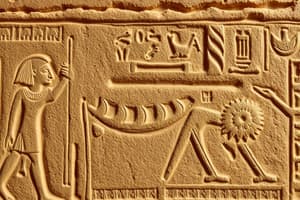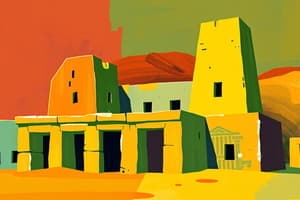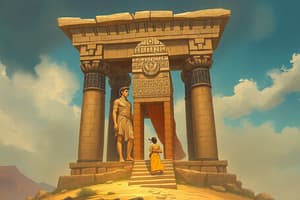Podcast
Questions and Answers
What era was marked by the development of Homo sapiens' tools and weapons?
What era was marked by the development of Homo sapiens' tools and weapons?
- Egyptian Art
- Ancient Art (correct)
- Hellenistic Art
- Medieval Art
Where were unique artworks incorporated into tombs for the deceased's soul?
Where were unique artworks incorporated into tombs for the deceased's soul?
- Medieval Art
- Hellenistic Art
- Egyptian Art (correct)
- Ancient Art
What characterized Renaissance art in terms of emphasis?
What characterized Renaissance art in terms of emphasis?
- Dramatic effects using light and shadow
- Incorporation of biblical subjects
- Simplicity, gesture, and expression (correct)
- Ornate and sensual decorations
During which period did art evolve with biblical subjects and classical mythology?
During which period did art evolve with biblical subjects and classical mythology?
Which period saw the breakdown of dynasties into smaller Greek kingdoms?
Which period saw the breakdown of dynasties into smaller Greek kingdoms?
What was characteristic of the baroque period?
What was characteristic of the baroque period?
Which era introduced Romanesque, Gothic, and Byzantine art periods?
Which era introduced Romanesque, Gothic, and Byzantine art periods?
Artists in which period used elements like light and shadow to create dramatic effects?
Artists in which period used elements like light and shadow to create dramatic effects?
Which art era featured works depicting the sun, moon, stars, and sacred animals?
Which art era featured works depicting the sun, moon, stars, and sacred animals?
What was the characteristic of Hellenistic art in terms of historical context?
What was the characteristic of Hellenistic art in terms of historical context?
Flashcards are hidden until you start studying
Study Notes
Ancient Art (3000 BC - 300 BC)
- The Paleolithic era lasted for 2.5-3 million years and saw the development of Homo sapiens' tools and weapons, leading to increased human culture.
Egyptian Art (31st century BC - 4th century AD)
- Egypt is a renowned site for ancient civilization, known for its advanced and unique artworks.
- Artworks were carved in stones and woods, depicting the sun, moon, stars, and sacred animals.
- These artworks were incorporated into tombs to assist the deceased's soul.
Hellenistic Art (4th century - 1st century BC)
- Hellenistic art emerged during Alexander the Great's time, when his conquered lands were divided among his generals.
- This led to the breakdown of dynasties into smaller Greek kingdoms.
Medieval Art
- The medieval period spanned from the fall of the Roman Empire to the Renaissance.
- Art evolved to focus on biblical subjects, Christian dogma, and classical mythology.
- This period saw the introduction of Romanesque, Gothic, and Byzantine art styles.
Renaissance Art
- The Renaissance was a period of rebirth, characterized by humanists seeking fulfillment in daily life.
- Humanists believed in dignity and worth, and promoted humanities like philosophy, history, Latin, and Greek.
- Renaissance art emphasized simplicity, gesture, and expression.
Baroque Art
- The baroque period was characterized by ornate and sensual decorations, flourishing in the 17th century.
- Artists used light and shadow to create dramatic effects in their paintings.
- Baroque art featured diagonal, twists, and zigzags in its compositions.
Studying That Suits You
Use AI to generate personalized quizzes and flashcards to suit your learning preferences.




